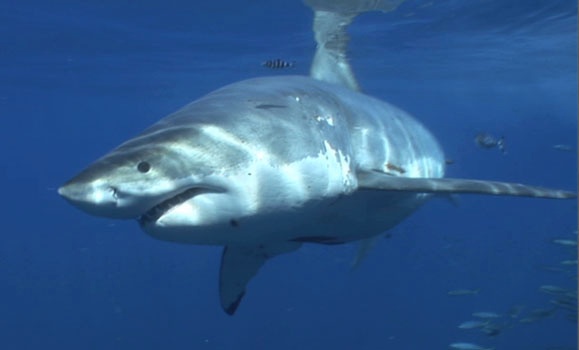For five nerve-wracking minutes, Chris Harvey-Clark knew what it was to be hunted.
The veteran diver and a friend were swimming through waters just outside the mouth of Halifax Harbour, hoping to see some of the torpedo rays he studies while also taking in the wreck of HMS Letitia, a WW 1 hospital ship.
As the pair headed back to their descent line and were about to slowly ascend to the boat, Dr. Harvey-Clark saw the silhouette of an animal he knew instantly to be a great white shark. The water was so clear at 23 metres down that he could easily make out the shark’s distinctive counter shading, snout and huge tail. He could also see that it was about three metres long and likely an older juvenile — meaning, it could be overly inquisitive and less discerning when deciding what to chomp into.
Sharks at the three-metre stage are just making the transition from fish to mammal as their main diet source. Fred Whoriskey, executive director of the Ocean Tracking Network (OTN) at Dal and Dr. Harvey-Clark’s partner in the torpedo ray research, has had two Slocum gliders — eight-foot autonomous aluminum research instrument platforms — attacked and damaged by probable white sharks in waters off Nova Scotia.
“At that age, they’re testing everything out so those are the sharks I fear the most,” Dr. Harvey-Clark, Dalhousie’s veterinarian and director of animal care, said after his underwater encounter at around noon last Tuesday.
“It’s one thing to have a shark do a drive-by and check you out once, but if the shark comes back repeatedly that’s a predatory investigation going on and you don’t want to be at the bitter end of that.
“That is the feeling of being hunted and it’s not a good feeling.”
'A scary scene'
Dr. Harvey-Clark, who also teaches Dal’s summer shark course, was positioned below the shark on a rocky slope and about eight metres away from the animal on its first pass. He started banging on his tank with his light to alert his friend, who was looking in a different direction. Moments later, the shark made a second pass approximately six metres away — close enough for Dr. Harvey-Clark to lock eyes with it.
“I decided it was time to get the hell out of there,” he says with a chuckle. “It was all murked out and that’s a very dangerous place to be.”
At that point, Dr. Harvey-Clark’s diving partner saw the shark silhouetted dramatically about 11 metres away from them as it passed for third time and they decided to get back to their ascent line as quickly as possible.
The two would normally do a decompression stop on the way up to their boat to allow the body to expel dissolved gases in the blood and prevent sickness. But they decided to forego the safety measure since they feared the shark was monitoring them and they would have trouble seeing much of anything as they moved through the final nine metres of water that was churned by very rough seas, with two-and-a-half metre visibility.
For Dr. Harvey-Clark, that was the most stressful period as he considered all of the odds stacking up against them.
“The visibility was so bad you couldn’t see the end of your fins, you’re in murky water, we were right around the corner from where there are seals with a foraging shark nearby and no ability to fend it off so that is about the worst it gets,” he says.
“I’ve been in the water with every kind of shark, but this is a scary shark and a scary scene.”
Warmer waters
The pair made it safely back on board their boat, unleashed some colourful expressions and then monitored themselves for decompression sickness. Luckily, neither suffered any effects from their rapid ascent.
Dr. Harvey-Clark also notified local dive shops that regularly take recreational divers out to nearby sites of the shark’s presence in the area.
He also noted that the water temperature seemed higher than normal for this time of year, registering 12 C at 33.5 metres feet below and 8 C at 91 metres. It also seemed odd to Dr. Harvey-Clark that they would encounter a great white at that time of day, since they typically forage either early in the morning or late afternoon. He also thought they would be gone from the area by now and moving south as part of their usual migration.
“The water’s still warm and the sharks are still here,” he said, noting that this could be the first verified white shark sighting by divers in the North Atlantic.
He says there also seem to be more sharks in the region, adding that over three days he recorded 22 encounters with great whites off Lunenburg last summer while filming a documentary. A seal was also found in early October with a large chunk taken out of its back near Duncan’s Cove, and later washed up dead.
Dr. Whoriskey said it’s not that unusual to see great whites this time of year, but water temperatures may be affecting their behaviour.
“Our records of sharks electronically tagged by OTN partners are showing that in recent years the whites are around Nova Scotia into early December, with our peak number of detections in October and November,” he said. “So, this may not be that unusual. The warmer temperatures a bit later into the season may be making them more active and increasing encounter probabilities, however.
“There is also the possibility that Chris smells particularly tasty!”

